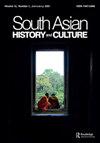Preliminary Study on Geoarchaeology of the Batu Kalde Temple, Pangandaran, West Java, Indonesia
IF 0.3
0 ASIAN STUDIES
引用次数: 0
Abstract
The Batu Kalde Site is a ruin of Hindu Temple in Pangandaran, West Java, Indonesia. Despite it has been reported since 1915 and subsequently studied by several archaeological teams, a lot of aspects including geoarchaeology of this temple are still unrevealed. This preliminary study was an overview of general aspects of geoarchaeology of the temple. The result shows that the temple was constructed before the 14th century by a population of farmers and fishermen lived on the fertile coastal plain of Pangandaran in south coast of Java Island. The temple was constructed in a narrow coastal plain of a small island on a Quaternary marine sediment offshore of the present Pangandaran coast. The existing tombolo morphology of Penanjung has not been completely formed when the temple was being constructed. The temple was constructed using bedded sandstone of the Pamutuan Formation quarried from outcrops in the vicinity of the temple. This study shows that utilization of materials from local available resource might have been a model of temple construction within the classical period in the period of between the 7-14th century in West Java, Indonesia.印度尼西亚西爪哇邦干达兰Batu Kalde寺地质考古初步研究
Batu Kalde遗址是印度尼西亚西爪哇邦干达兰的印度教寺庙遗址。尽管自1915年以来就有报道,随后又有几个考古小组对其进行了研究,但这座寺庙的许多方面,包括地质考古学,仍然没有揭示出来。这项初步研究是对寺庙地质考古的一般方面的概述。结果表明,这座寺庙是在14世纪之前由居住在爪哇岛南部海岸肥沃的Pangandaran沿海平原上的农民和渔民建造的。这座寺庙建在一个小岛的一个狭窄的沿海平原上,位于现在的庞干达兰海岸的第四纪海洋沉积物上。在建寺的时候,毗南中现存的碑文形态还没有完全形成。这座寺庙是用从寺庙附近的露头开采的帕木团组的层状砂岩建造的。这项研究表明,在印度尼西亚西爪哇7-14世纪的古典时期,利用当地可用资源的材料可能是寺庙建设的一种模式。
本文章由计算机程序翻译,如有差异,请以英文原文为准。
求助全文
约1分钟内获得全文
求助全文

 求助内容:
求助内容: 应助结果提醒方式:
应助结果提醒方式:


